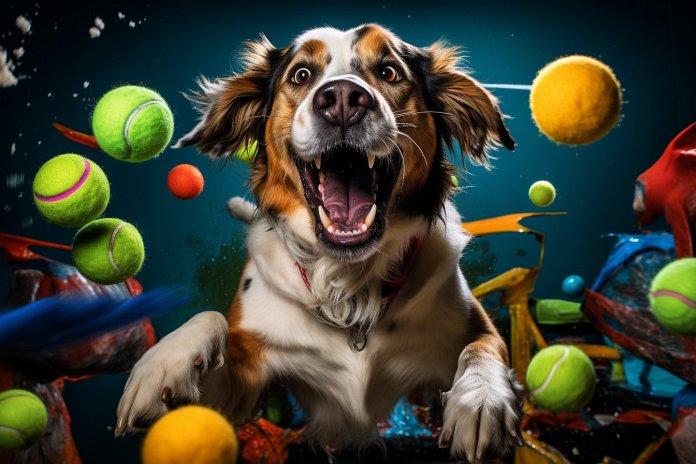
Is your dog exhibiting obsessive behaviors like chasing their tail or sucking on their paws? They may have a condition called canine compulsive disorder or CCD. This article explores the signs of CCD and provides information on its causes and treatment options.
Signs Your Dog Has Canine Compulsive Disorder
Dogs with CCD may exhibit behaviors such as chasing their tail, spinning in circles, staring blankly, guarding their toys and food excessively, or catching imaginary flies. They may also harm themselves by continuously licking their paws. Some dogs with CCD become hyper-attached to their owners and display aggressive behavior towards anyone who comes near. These dogs may experience anxiety, which can eventually affect their overall health.
Body Language
Signs that your dog may have CCD include growling, staring, barking, panting, pacing, biting, licking, and dilated pupils.
History of Compulsive/Obsessive Behavior in Dogs
Dogs have evolved alongside humans and share genetic traits that can lead to compulsive behavior. It is uncertain whether wolves in the wild display similar behaviors, but dogs are prone to obsessive tendencies due to their close relationship with humans.
Science Investigates Dogs and Obsessive Disorders
Stress can contribute to the development of obsessive-compulsive disorder in both humans and dogs. Dogs that have experienced mistreatment or neglect, as well as those kept in restrictive environments, are more likely to develop CCD. Certain breeds, such as Cavalier King Charles, Dobermans, Labradors, and Golden Retrievers, are also more prone to CCD.
Training Dogs Who Feel Obsessive
When dogs feel overwhelmed, they may develop obsessive behaviors as a coping mechanism. Environmental factors and genetics play a role in the development of CCD. Medication and behavioral therapy can be helpful in managing CCD. Exercise, environmental modifications, and puzzle toys can also help redirect a dog’s obsessive thoughts. It’s important to avoid punishing dogs with CCD, as it can increase their anxiety.
Conclusion
Canine compulsive disorder is a real condition that can affect dogs. Understanding the signs and causes of CCD can help dog owners recognize and manage this condition. Working with a veterinarian and behavioral expert can provide guidance on treatment options, including medication and holistic therapies.
“Unleash your understanding: Canine Compulsive Disorder is real and it affects more dogs than you may think”

Tips & Things to Know
1️⃣ Look out for signs of canine compulsive disorder (CCD) in your dog, such as obsessive behaviors like chasing their tail, pacing, or staring blankly into space. Dogs with CCD may also exhibit aggression, self-harming, or hyper-attachment to their owners.
2️⃣ Understand that genetics and environmental factors play a role in the development of CCD in dogs. Stressful experiences, mistreatment, or living in restrictive environments can contribute to obsessive behaviors. Certain breeds may be more prone to CCD.
3️⃣ Seek professional help if your dog is exhibiting signs of CCD. A veterinarian can provide medication, such as doggy Prozac, to help manage the disorder. Additionally, behavioral experts can offer guidance on training techniques and holistic therapies, such as massage or herbal remedies, may also be options to consider. Avoid punishment, as it will only increase anxiety in dogs with CCD.
Frequently Asked Questions, Answered ✅
1. What are some signs that my dog may have canine compulsive disorder?
– Some signs include chasing their tail, spinning in circles, excessively licking their paws, guarding toys and food, and displaying aggressive behavior.
2. Are certain breeds more prone to developing canine compulsive disorder?
– Yes, certain breeds such as Cavalier King Charles, Dobermans, Labradors, and Golden Retrievers are more prone to developing obsessive tendencies.
3. Can stress and mistreatment contribute to the development of canine compulsive disorder?
– Yes, stress and mistreatment can contribute to the development of obsessive behaviors in dogs. Dogs that have been tied up outside for long periods of time or have had frightening experiences are more likely to develop CCD.
4. How can I help train my dog who is displaying obsessive behavior?
– Providing sufficient exercise, removing triggers of obsession, and engaging in mentally stimulating activities such as puzzle games or joining an agility club can help distract dogs from their compulsive thoughts. Medication and holistic therapies may also be recommended by a vet or behavioral expert.
5. Can dogs with canine compulsive disorder be re-homed?
– Dogs with CCD may have a harder time being re-homed due to their obsessive behaviors. It is important to address their condition and seek appropriate treatment to improve their quality of life and increase their chances of finding a suitable home.